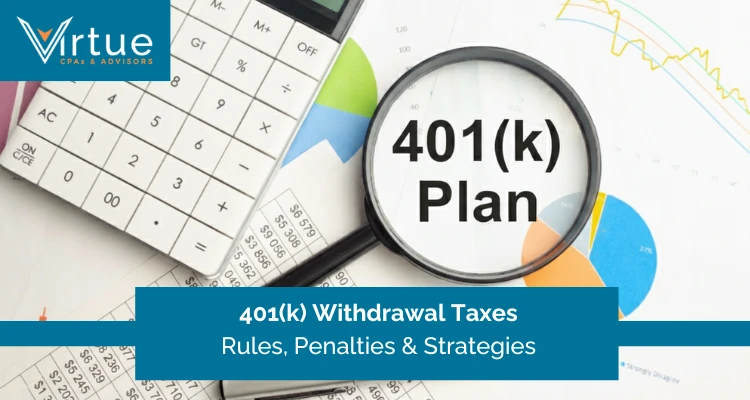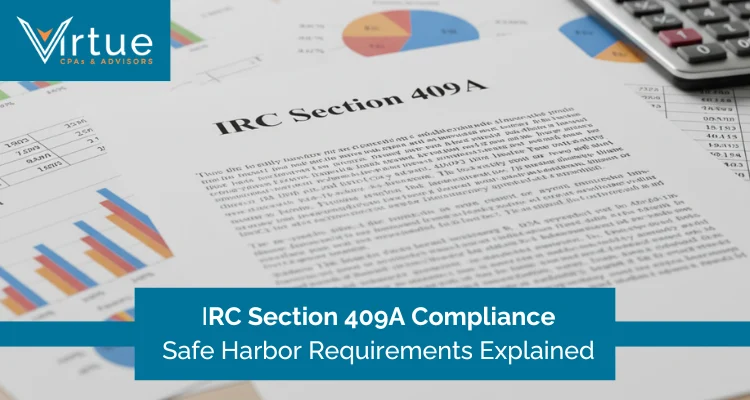You’re staring at your 401(k) statement, and you wonder: “If I need cash, can I just take some out? What taxes or penalties will I face?”
It’s tempting to dip into your retirement savings for emergencies, big purchases, or financial stressors.
But without knowing the rules, you could end up handing a big chunk of your money straight to Uncle Sam.
In this post, you’ll learn all about 401(k) withdrawal taxes—the rules, the penalties, and smart strategies to keep more of your hard-earned money.
Here’s what we’ll cover:
- Basics of 401(k) withdrawals
- How withdrawals are taxed
- Early‐withdrawal penalties and exceptions
- Required Minimum Distributions (RMDs)
- Strategies to minimize taxes
- Rollovers vs. withdrawals
Let’s dive in.
Basics of 401(k) Withdrawals
Before you make any moves, you need to know what a 401(k) really is—and how withdrawals work.
A 401(k) is a retirement plan your employer might offer. You contribute money (usually pre-tax, in a traditional 401(k)), and that money grows tax-deferred over time. That means you don’t pay tax on it now—only when you withdraw.
You may want to withdraw before retirement (for emergencies, home purchases, etc.) or begin withdrawing once you reach retirement age.
But not all withdrawals are equal—because when and how you withdraw affects your tax bill and your penalties.
One important distinction: traditional vs. Roth 401(k).
With a traditional 401(k), your contributions are pre-tax, so you didn’t pay taxes on them up front. Later, when you withdraw, you pay ordinary income tax on the full amount.
With a Roth 401(k), you already paid taxes on contributions, so qualified withdrawals (if you’ve met certain conditions) can be tax-free.
It helps to think of them side by side:
| Feature | Traditional 401(k) | Roth 401(k) |
|---|---|---|
| Contributions | Pre-tax | After-tax |
| Withdrawal taxation | Ordinary income tax | If qualified, tax-free |
| Benefit | Reduces current taxable income | Tax-free growth on qualified withdrawals |
You’ll also run into terms like distribution, rollover, and RMD (Required Minimum Distribution).
A distribution is when money is paid out to you. A rollover is moving money from one retirement account to another (to defer taxes). And RMDs are the minimum amounts you must withdraw by law after a certain age (we’ll talk more later).
Understanding these basics is your foundation. Now, let’s look at how taxes come into play.
Taxation Rules for 401(k) Withdrawals
When you take money out of your 401(k), you generally owe taxes—unless it’s a Roth and the withdrawal is qualified.
1. Traditional 401(k)
With a traditional 401(k), distributions are taxed as ordinary income.
That means when you withdraw, the full amount is added to your taxable income for the year, and you pay according to your tax bracket.
For example, if in a given year you have $50,000 of earned income, and you withdraw $10,000 from your 401(k), your total taxable income becomes $60,000 (plus any other income). The withdrawal is taxed at your marginal rate.
2. Roth 401(k)
If you meet the requirements (generally, you’re over 59½ and the account has been open for at least 5 years), your Roth 401(k) withdrawals are tax-free.
You already paid taxes on contributions, and qualified earnings grow tax-free.
If you don’t meet those requirements, part of your withdrawal may be taxable.
3. Federal vs. State Income Tax
You’ll owe federal income tax on traditional 401(k) withdrawals.
But you may also owe state income tax, depending on your state. Some states don’t tax retirement income; others tax it fully or partially.
Because of that, it’s smart to check your state’s rules—or get advice from a tax planner.
4. Effect on Tax Brackets
Big withdrawals can push you into a higher bracket.
So, if you withdraw a large sum in one year, you could end up paying a higher rate on parts of your income.
5. Withholding Rules
If you take a lump-sum distribution, IRS rules typically require 20% mandatory withholding on the taxable portion (for federal income tax).
If the withholding is more than the tax you ultimately owe, you’ll get a refund. If it's less, you’ll owe more at tax time.
Example
Suppose your taxable income (without withdrawal) is $60,000, putting you in the 22% tax bracket. You decide to withdraw $20,000 from your traditional 401(k). That $20,000 becomes taxable income, pushing your total to $80,000.
The extra $20,000 might be taxed partly at 22%, or some of it at a higher bracket, depending on how your income is structured.
Plus, 20% will likely be withheld up front (i.e. $4,000). You’ll reconcile the difference when you file taxes.
Early Withdrawal Penalties
When you withdraw money from a 401(k) before you reach age 59½, you usually face serious costs.
Let’s break it down.
What Is Early Withdrawal?
Any distribution taken before age 59½ (unless you qualify for an exception) is considered “early” and triggers a penalty.
The 10% Penalty
On top of ordinary income tax, the IRS adds a 10% penalty tax on the taxable portion of the withdrawal.
So, if you withdraw $10,000 (and it’s all taxable), you’ll owe $1,000 as a penalty plus the income taxes. That’s an immediate hit.
How Penalties Stack with Income Tax
The withdrawal is taxed as regular income, and then the 10% is added on top. It’s a double whammy.
Also, total taxes and penalties can push your effective cost much higher.
IRS Exceptions (Penalty Waivers)
There are cases where you can avoid the 10% penalty (though you’ll still owe income tax).
Some exceptions include:
- Disability
- Medical expenses exceeding a certain % of AGI
- First-time home purchase (up to a limit)
- Substantially Equal Periodic Payments (SEPP)
- Education expenses
- IRS levy
- Qualified birth or adoption distributions
- Separation from employment after age 55 (the “rule of 55”)
- Hardship or special distributions (depending on your plan)
For example, if you are permanently disabled, the penalty may not apply. Or, if you take consistent payments under SEPP rules, you can avoid the penalty—but you must follow strict guidelines.
Also, 401(k) plans may allow hardship withdrawals, though the plan’s rules and IRS rules determine whether the 10% penalty is waived.
One more: The CARES Act allowed penalty-free withdrawals for COVID-impacted individuals under certain conditions—in past years.
Required Minimum Distributions (RMDs)
Once you reach a certain age, the IRS forces you to begin withdrawing from your 401(k).
These are called Required Minimum Distributions (RMDs).
Why RMDs Exist
The IRS doesn’t want retirement accounts to grow tax-deferred forever without ever being taxed. RMD rules ensure you eventually take money out (and pay taxes).
Age Rules & SECURE Act Updates
Historically, RMDs began at age 70½. Then the SECURE Act changed it to age 72. Under SECURE 2.0, for many people, it's now age 73.
So, if you turn 72 or later (or 73, depending on your birth year), you’ll start taking RMDs.
How RMDs Are Calculated (Formula + Example)
The formula is roughly:
RMD = (Account balance at end of previous year) ÷ (Life expectancy factor from IRS table)
For example, if your account was $500,000 at the end of last year, and your IRS life expectancy factor is 25.6, then your RMD is $500,000 ÷ 25.6 ≈ $19,531.
You must take at least that much in the current year. You can withdraw more, but not less (unless exceptions apply).
Penalties for Missing RMDs
If you don’t take your full RMD, you risk a penalty. Previously, the penalty was a whopping 50% of the amount you should have withdrawn but didn’t.
Recent changes under SECURE 2.0 have reduced or softened penalties in some cases (consult a tax advisor).
Strategies to Minimize the Tax Burden
- Spread distributions across multiple accounts or years
- Use Qualified Charitable Distributions (QCDs)—you can have your RMD paid directly to a charity, which counts toward the RMD but isn’t taxable
- Do Roth conversions before RMD age
- Allocate investments to reduce tax drag
Estate Planning Impact
If you leave a 401(k) to a beneficiary, they might inherit special rules for required distributions.
Some beneficiaries can stretch distributions over their lifetime, while others must take them quickly. That affects tax planning too.
Strategies to Minimize Taxes on 401(k) Withdrawals
You don’t have to passively accept high tax bills. There are smart moves you can make to reduce taxes and penalties. Let’s look at your options.
Withdraw in Lower-Income Years
If you foresee a year where your income is low (say, early retirement, sabbatical, or job break), withdrawing more in that year helps you stay in a lower bracket. It’s all about timing.
Roth Conversions
Convert part of your traditional 401(k) or IRA to Roth before retirement or before RMDs kick in. You’ll pay income tax now, but future withdrawals (qualified ones) will be tax-free. It’s a trade-off, but it may save taxes in the long run.
Spread Withdrawals Over Years
Instead of one big withdrawal, take smaller ones each year. That smoothes your taxes and helps prevent pushing yourself into a higher bracket.
Use 401(k) Loans Instead of Withdrawals
If your plan allows loans, borrowing from your own account can be cheaper (no immediate tax, no 10% penalty). But if you leave your job and can’t repay, you may owe taxes and penalties on the outstanding balance.
Coordinate with Social Security Benefits
If you're drawing Social Security, strategically timing 401(k) withdrawals can help you avoid too much additional taxable income in one year.
Tax Diversification Strategy
Don’t keep all your eggs in one basket. Maintain a mix of traditional accounts, Roth accounts, and taxable investments. That gives you flexibility later to withdraw from the most tax-efficient source.
Charitable Giving via QCDs
If you’re 70½ or older (and meet the rules), you can direct your RMD to a qualified charity. That counts toward your RMD but isn’t taxed. It’s a neat way to reduce your taxable income.
Rolling Over a 401(k) vs. Taking Withdrawals
Before you grab that check, weigh your rollover options.
Direct Rollover vs. Cashing Out
A direct rollover moves your funds from a 401(k) into another tax-advantaged account (like an IRA or another 401(k) plan). That way, taxes and penalties are deferred (or avoided).
If you cash out, the distribution is taxable and possibly penalized.
Tax Implications of Rollovers
If done correctly, rollovers are not taxable events. But you must follow rules carefully (e.g., 60-day window).
If you withhold taxes during a rollover, you’ll need extra funds to make up the difference to preserve the full rollover amount.
Avoiding Double Taxation Mistakes
Some people withdraw and think they’ll roll over later—if they don’t complete the rollover correctly (or miss the deadline), they can be taxed twice.
Best Practices for Rollovers
- Use direct trustee-to-trustee transfers
- Don’t let the check pass through your hands (if possible)
- Roll over the full taxable amount, including withheld taxes if needed
- Watch the employer plan rules
Conclusion
Navigating 401(k) withdrawal taxes can feel like walking through a minefield, but with the right knowledge, you can make smart moves.
Even one misstep—from missing an RMD to an incorrect rollover—can cost you thousands in penalties, interest, or lost tax advantages. But here’s the thing: you don’t have to figure it out alone.
Virtue CPAs specializes in retirement planning, tax strategy, and helping people like you get the most from their 401(k) accounts.
When you reach out to Virtue CPAs:
- We’ll review your full financial picture
- We’ll map a withdrawal strategy that minimizes taxes
- We’ll help with rollovers, Roth conversions, and RMD planning
- We’ll support you through complex scenarios
Don’t let IRS rules chew up your retirement savings.
Contact Virtue CPAs today for a personalized consultation and make sure your 401(k) withdrawals are smart, tax-efficient, and aligned with your goals.
Frequently Asked Questions







